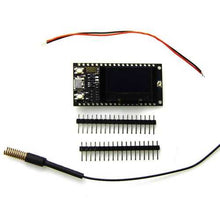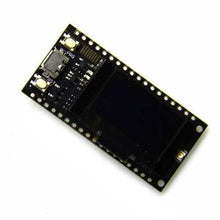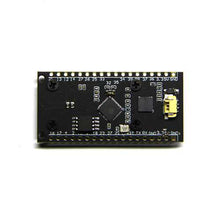Product Description:
The 433MHz antenna must be used in conjunction with the IPEX interface (if the antenna is not connected, it may damage the LoRa chip)Lithium battery charging and discharging circuit, when the battery is full, the blue LED will stop working. When using, pay attention to the positive and negative of the battery, otherwise it will be damaged.Using the IO port touch screen touch signal input, you need to add the 100nF pull-down capacitor at this pin!Pin reference description:
For more product information, click https://drive.google.com/file/d/1L8ll-DeAC2SATBZn0-KbSaZsrinbnXkF/view
Test details:
Click links for more details: https://eyun.baidu.com/s/3hsiTNgg
Note:This product does not include the battery.
Package included:
2 x ESP32 OLED2 x Line4 x pin2 x 433m Spring Antenna
For example One:(1) LoRaSender#include#include#include// GPIO5 -- SX1278's SCK// GPIO19 -- SX1278's MISO// GPIO27 -- SX1278's MOSI// GPIO18 -- SX1278's CS// GPIO14 -- SX1278's RESET// GPIO26 -- SX1278's IRQ(Interrupt Request) #define SS 18#define RST 14#define DI0 26#define BAND 433E6 int counter = 0; void setup() { pinMode(25,OUTPUT); //Send success, LED will bright 1 second Serial.begin(115200); while (!Serial); //If just the the basic function, must connect to a computer SPI.begin(5,19,27,18); LoRa.setPins(SS,RST,DI0);// Serial.println("LoRa Sender"); if (!LoRa.begin(BAND)) { Serial.println("Starting LoRa failed!"); while (1); } Serial.println("LoRa Initial OK!");} void loop() { Serial.print("Sending packet: "); Serial.println(counter); // send packet LoRa.beginPacket(); LoRa.print("hello "); LoRa.print(counter); LoRa.endPacket(); counter++; digitalWrite(25, HIGH); // turn the LED on (HIGH is the voltage level) delay(1000); // wait for a second digitalWrite(25, LOW); // turn the LED off by making the voltage LOW delay(1000); // wait for a second delay(3000);} For example Two(2)LoRaReceiver#include#include // GPIO5 -- SX1278's SCK// GPIO19 -- SX1278's MISO// GPIO27 -- SX1278's MOSI// GPIO18 -- SX1278's CS// GPIO14 -- SX1278's RESET// GPIO26 -- SX1278's IRQ(Interrupt Request) #define SS 18#define RST 14#define DI0 26#define BAND 433E6 void setup() { Serial.begin(115200); while (!Serial); //if just the the basic function, must connect to a computer delay(1000); Serial.println("LoRa Receiver"); SPI.begin(5,19,27,18); LoRa.setPins(SS,RST,DI0); if (!LoRa.begin(BAND)) { Serial.println("Starting LoRa failed!"); while (1); }} void loop() { // try to parse packet int packetSize = LoRa.parsePacket(); if (packetSize) {// received a packet Serial.print("Received packet '"); // read packet while (LoRa.available()) { Serial.print((char)LoRa.read()); } // print RSSI of packet Serial.print("' with RSSI "); Serial.println(LoRa.packetRssi()); }} For example three(3)LoRaReceiverCallback#include#include // GPIO5 -- SX1278's SCK// GPIO19 -- SX1278's MISO// GPIO27 -- SX1278's MOSI// GPIO18 -- SX1278's CS// GPIO14 -- SX1278's RESET// GPIO26 -- SX1278's IRQ(Interrupt Request) #define SS 18#define RST 14#define DI0 26#define BAND 433E6 void setup() { Serial.begin(115200); while (!Serial); //if just the the basic function, must connect to a computer SPI.begin(5,19,27,18); LoRa.setPins(SS,RST,DI0); Serial.println("LoRa Receiver Callback"); if (!LoRa.begin(BAND)) { Serial.println("Starting LoRa failed!"); while (1); } // register the receive callback LoRa.onReceive(onReceive); // put the radio into receive mode LoRa.receive();} void loop() { // do nothing} void onReceive(int packetSize) { // received a packet Serial.print("Received packet '"); // read packet for (int i = 0; i < packetSize; i++) { Serial.print((char)LoRa.read()); } // print RSSI of packet Serial.print("' with RSSI "); Serial.println(LoRa.packetRssi());}?For example four#include // Only needed for 1.6.5 and earlier#include "SSD1306.h" // alias for `#include "SSD1306Wire.h"`#include "images.h" //OLED pins to ESP32 0.96OLEDGPIOs via this connecthin://OLED_SDA -- GPIO4//OLED_SCL -- GPIO15//OLED_RST -- GPIO16 SSD1306 display(0x3c, 4, 15); #define DEMO_DURATION 3000typedef void (*Demo)(void);int demoMode = 0;int counter = 1; void setup() { pinMode(16,OUTPUT); digitalWrite(16, LOW); // set GPIO16 low to reset OLED delay(50); digitalWrite(16, HIGH); // while OLED is running, must set GPIO16 in high Serial.begin(115200); Serial.println(); Serial.println(); // Initialising the UI will init the display too. display.init(); display.flipScreenVertically(); display.setFont(ArialMT_Plain_10); } void drawFontFaceDemo() { // Font Demo1 // create more fonts at http://oleddisplay.squix.ch/ display.setTextAlignment(TEXT_ALIGN_LEFT); display.setFont(ArialMT_Plain_10); display.drawString(0, 0, "Hello world"); display.setFont(ArialMT_Plain_16); display.drawString(0, 10, "Hello world"); display.setFont(ArialMT_Plain_24); display.drawString(0, 26, "Hello world");} void drawTextFlowDemo() { display.setFont(ArialMT_Plain_10); display.setTextAlignment(TEXT_ALIGN_LEFT); display.drawStringMaxWidth(0, 0, 128, "Lorem ipsumn dolor sit amet, consetetur sadipscing elitr, sed diam nonumy eirmod tempor invidunt ut labore." );} void drawTextAlignmentDemo() { // Text alignment demodisplay.setFont(ArialMT_Plain_10); // The coordinates define the left starting point of the text display.setTextAlignment(TEXT_ALIGN_LEFT); display.drawString(0, 10, "Left aligned (0,10)"); // The coordinates define the center of the text display.setTextAlignment(TEXT_ALIGN_CENTER); display.drawString(64, 22, "Center aligned (64,22)"); // The coordinates define the right end of the text display.setTextAlignment(TEXT_ALIGN_RIGHT); display.drawString(128, 33, "Right aligned (128,33)");} void drawRectDemo() { // Draw a pixel at given position for (int i = 0; i < 10; i++) { display.setPixel(i, i); display.setPixel(10 - i, i); } display.drawRect(12, 12, 20, 20); // Fill the rectangle display.fillRect(14, 14, 17, 17); // Draw a line horizontally display.drawHorizontalLine(0, 40, 20); // Draw a line horizontally display.drawVerticalLine(40, 0, 20);} void drawCircleDemo() { for (int i=1; i < 8; i++) { display.setColor(WHITE); display.drawCircle(32, 32, i*3); if (i % 2 == 0) { display.setColor(BLACK); } display.fillCircle(96, 32, 32 - i* 3); }}void drawProgressBarDemo() { int progress = (counter / 5) % 100; // draw the progress bar display.drawProgressBar(0, 32, 120, 10, progress); // draw the percentage as String display.setTextAlignment(TEXT_ALIGN_CENTER); display.drawString(64, 15, String(progress) + "%");} void drawImageDemo() { // see http://blog.squix.org/2015/05/esp8266-nodemcu-how-to-create-xbm.html // on how to create xbm files display.drawXbm(34, 14, WiFi_Logo_width, WiFi_Logo_height, WiFi_Logo_bits);} Demo demos[] = {drawFontFaceDemo, drawTextFlowDemo, drawTextAlignmentDemo, drawRectDemo, drawCircleDemo, drawProgressBarDemo, drawImageDemo};int demoLength = (sizeof(demos) / sizeof(Demo));long timeSinceLastModeSwitch = 0; void loop() { // clear the display display.clear(); // draw the current demo method demos[demoMode](); display.setTextAlignment(TEXT_ALIGN_RIGHT); display.drawString(10, 128, String(millis())); // write the buffer to the display display.display(); if (millis() - timeSinceLastModeSwitch > DEMO_DURATION) { demoMode = (demoMode + 1) % demoLength; timeSinceLastModeSwitch = millis(); } counter++; delay(10);}








